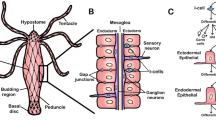Abstract
THE study of mechanisms affecting the rate of ageing can be facilitated by naturally occurring phenomena, innate to some organisms, that enable the species to retard its ageing rate and extend its life span1. Such a phenomenon exists in certain species of nematode. Larval forms of the free-living soil nema-tode, Caenorhabditis elegans, possess the ability to enter a semi-dormant, quiescent state referred to as the dauer larval stage (German, “enduring” larva). Newly hatched larvae of C. elegans undergo four larval stages (L1–L4) punctuated by moulting. If larvae are starved, they will enter the dauer state during the second larval moult. At this time, the old cuticle is replaced by a special, relatively impermeable cuticle unique to dauer larvae2.
Similar content being viewed by others
References
Cooper, A. F., Jr, and Van Gundy, S. D., in Plant Parasitic Nematodes, 2 (edit. by Zuckermann, Mai and Rhode), ch. 27 (1971).
Cassada, R. C., and Russell, R. L., Devl Biol., 46, 326–342 (1975).
Hedgecock, E. M., and Russell, R. L., Proc. natn. Acad. Sci. U.S.A., 72, 4061–4065 (1975).
Hirsh, D., and Oppenheim, D., and Klass, M., Devl Biol., 49, 200–219 (1976).
Croll, N. A., and Matthews, B. E., Parasitology, 66, 279–289 (1973).
Author information
Authors and Affiliations
Rights and permissions
About this article
Cite this article
KLASS, M., HIRSH, D. Non-ageing developmental variant of Caenorhabditis elegans. Nature 260, 523–525 (1976). https://doi.org/10.1038/260523a0
Received:
Accepted:
Issue Date:
DOI: https://doi.org/10.1038/260523a0
- Springer Nature Limited
This article is cited by
-
Colony level fitness analysis identifies a trade-off between population growth rate and dauer yield in Caenorhabditis elegans
BMC Ecology and Evolution (2024)
-
Ageing as a software design flaw
Genome Biology (2023)
-
Long-term imaging reveals behavioral plasticity during C. elegans dauer exit
BMC Biology (2022)
-
The plasticity of ageing and the rediscovery of ground-state prevention
History and Philosophy of the Life Sciences (2021)
-
Stage-specific transcriptome of Bursaphelenchus xylophilus reveals temporal regulation of effector genes and roles of the dauer-like stages in the lifecycle
Scientific Reports (2019)





